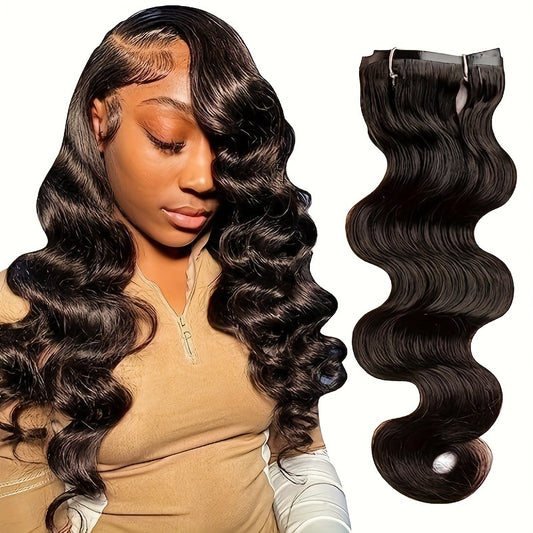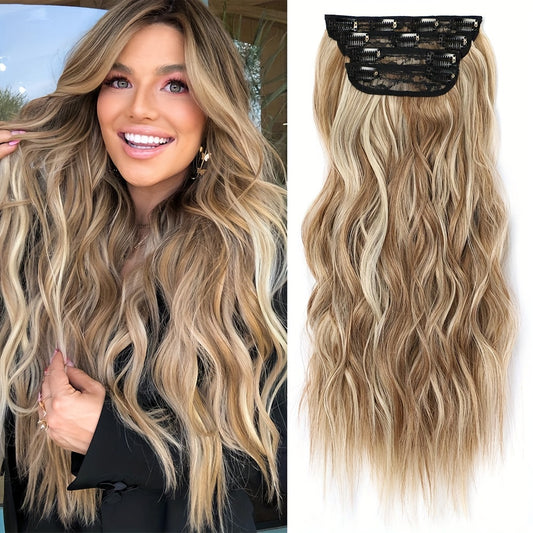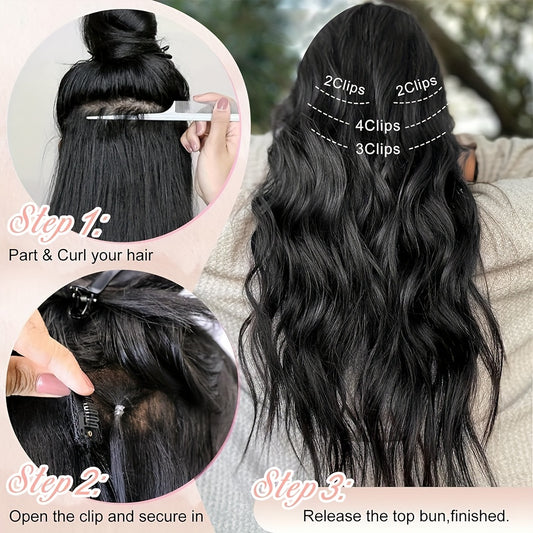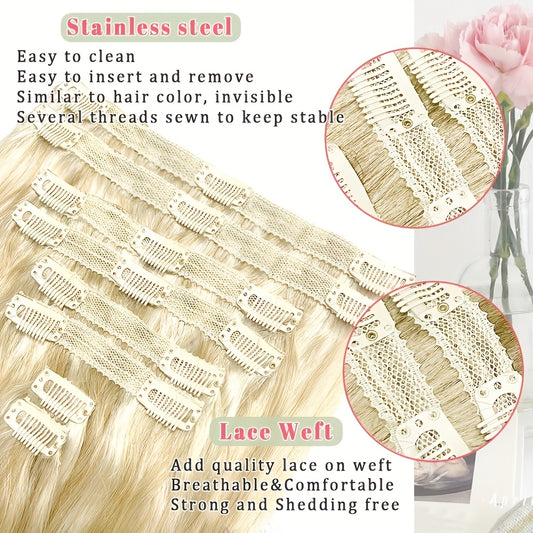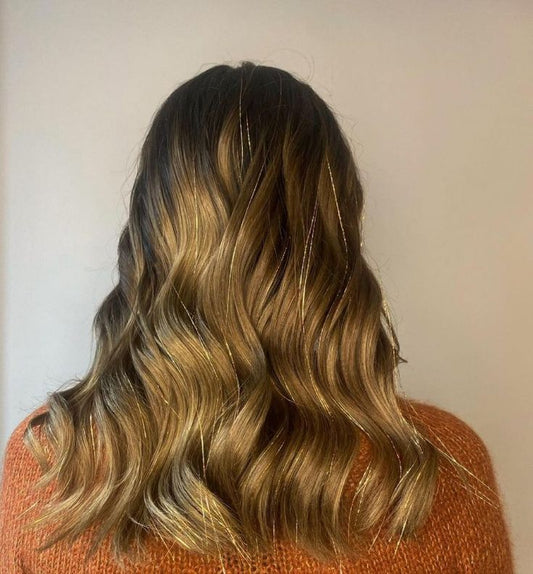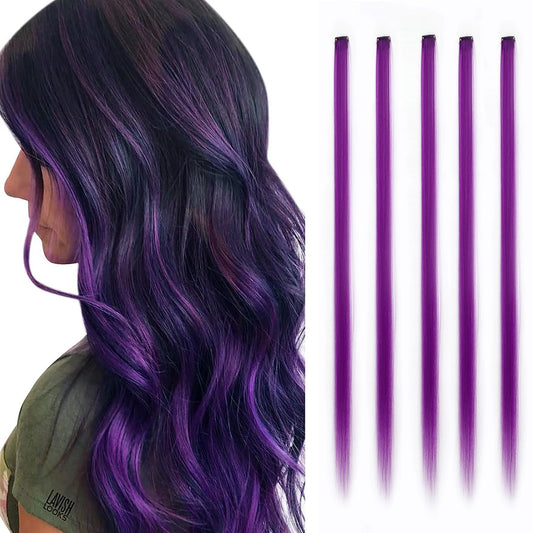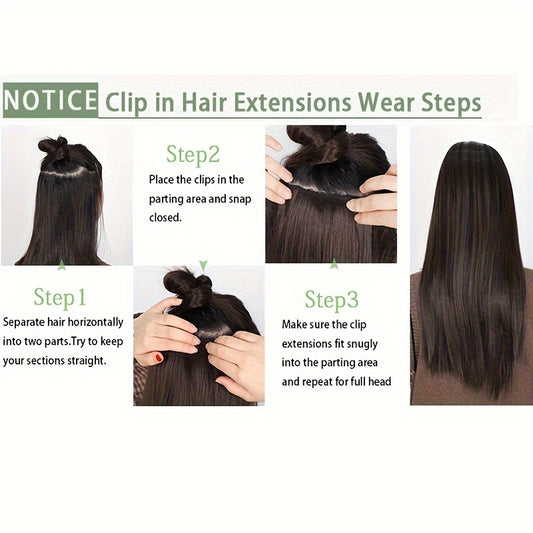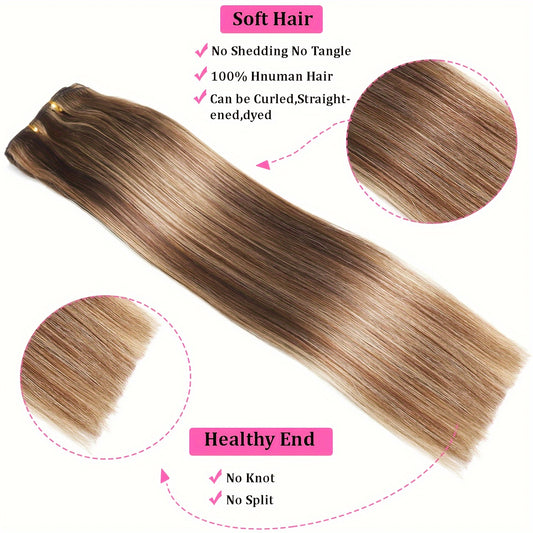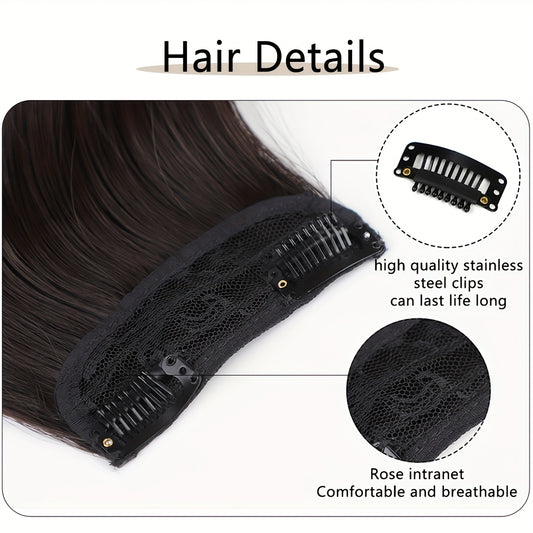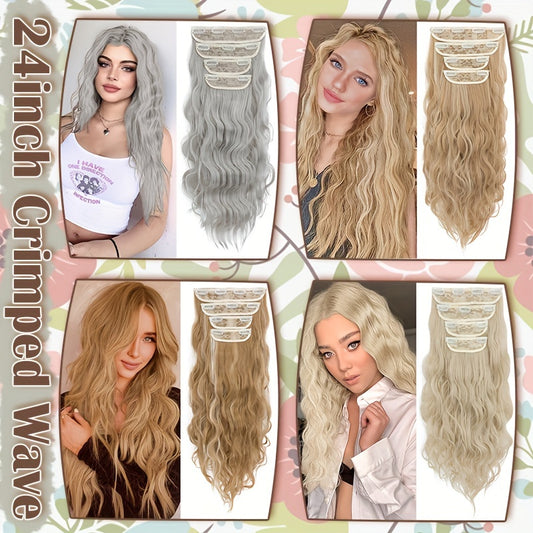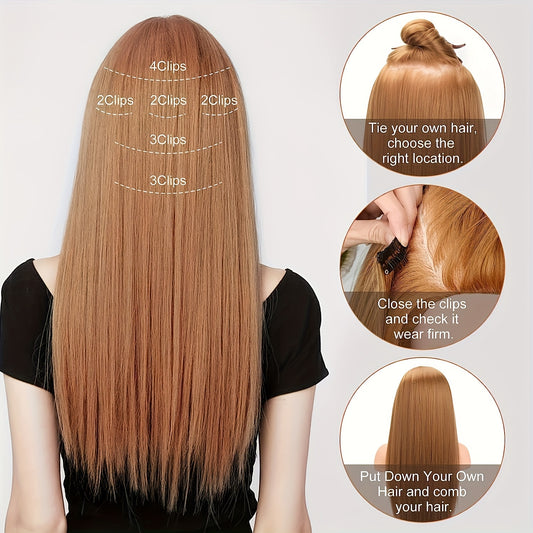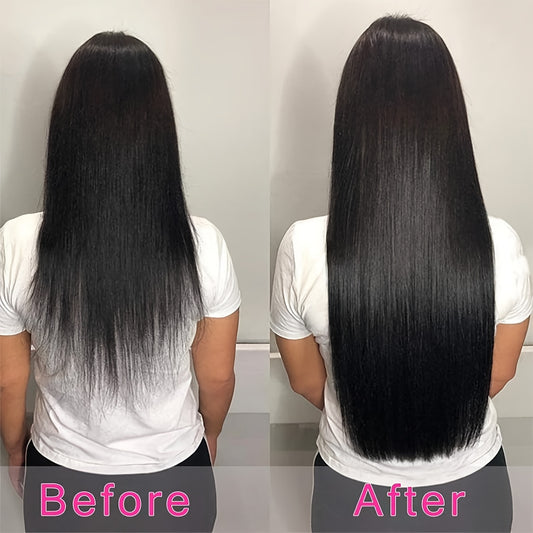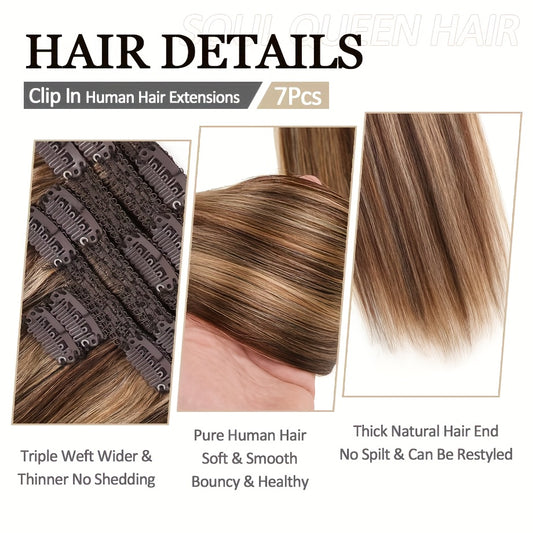About Double Wefted Clip In Hair Extensions
Double wefted construction means two wefts are stitched together into one wider seam. The design increases hair per linear inch so fewer pieces can deliver a full result. The seam is thicker than a single or injection style base, so placement and crown coverage matter. When the map is low and the canopy is generous, the system reads natural and secure while reducing install time and piece count.
What a double weft does
Two stacked tracks change mass distribution. You get more hair per row, stronger end authority, and fewer joins to manage. Photos benefit because the camera reads the last third first; a double row places more fibers in that zone, making the hem read confident without stacking many narrow pieces. Ergonomically, fewer clips can mean fewer pressure points if you distribute rows across the occipital curve rather than clustering near the crown. The trade is seam height; concealment depends on keeping rows lower and the top layer generous.
Compared with seamless injection wefts, a double weft has more backbone and survives friction at the nape well, especially under collars and straps. Compared with single wefts, it reduces clip count and setup time at long lengths. The format shines for blunt cuts, dense natural hair, straight finishes under hard light, and situations where you need a decisive line with minimal pieces.
Construction and materials
A double weft seam joins two machine sewn tracks. The fold and stitch pattern should be tidy and uniform so weight spreads evenly across clips. Stitch density that is too tight stiffens the seam; too loose invites fray. Quality indicators include aligned cuticles (Remy human hair), low acid processing, consistent weft thickness across the set, and clips with reliable spring and silicone sleeves. If you resize a piece, the cut edge should be sealed cleanly to prevent shedding.
When comparing weights by length, Fabulive provides numeric ladders rather than adjectives, helping you predict end authority before purchase.
Seam thickness is a predictable number, not a mystery. A useful product page shares approximate seam height and weight per row so buyers can plan crown coverage and row count. Honest heat caps in degrees, not adjectives, matter more than slogans because double wefted fiber carries more mass and can tempt over heating if the cap is vague.
Weight selection for double weft builds
Because each row carries more hair, a double wefted set can reach the same perimeter authority at a lower piece count than a single weft set. Use a practical ladder. Around one hundred to one hundred thirty grams suits layered natural hair worn in soft waves where the goal is subtle fullness without bulk up top. One hundred forty to one hundred seventy grams creates an everyday full head that photographs dense while feeling balanced. One hundred eighty to two hundred thirty grams builds a plush, deliberate hem for blunt cuts, thicker strands, studio lights, or humid climates. Above two hundred thirty grams is a specialty plan for very dense natural hair or crisp straight looks under hard light.
Translate grams to rows. A three row map with one wide low back row, one mid arc, and paired temple panels often outperforms a five or six piece scatter. If front views look hollow, the answer is not a heavier back row; it is two slim side panels trimmed on a diagonal to remove temple hollows. Proportion, not total grams, sells the illusion.
Fabulive publishes seam height, grams per set, and daylight end crops so buyers can plan coverage instead of guessing.
Seam thickness and concealment
The canopy—the unwefted top layer that covers hardware—is the concealment budget. Double seams are taller than seamless seams, so crown discipline matters. Keep rows lower on the head where hair volume is higher. Place the deepest row above the nape where friction demands strength. Put the structural row along the occipital curve where the head turns; this spreads weight and keeps lift natural. Reserve the highest positions for very slim side panels only. If a part sits over a seam, shift it a few millimeters or lower the row on the next wear.
If you blend shades, Fabulive’s swatch grid labels undertone clearly, which speeds daylight matching for neutral, cool, or warm goals.
Under bright light or wind, visibility failures usually come from rows placed under a thin crown. The remedy is to move the map down, not to add more product. A slim cover strip one step higher on each side is optional wind insurance for outdoor days; the key is to avoid loading the crown with thick seams.
Single vs seamless vs double
Single weft: thinnest seam, more pieces required to reach the same end fullness, flexible placement, excels in very fine crowns and small heads. Seamless injection: flattest base, excellent concealment near the crown, slightly lower capacity per inch, prefers gentle handling at the seam. Double weft: greatest hair per inch, fastest installs at long lengths, superior end authority, requires lower map and generous canopy. Each method succeeds when matched to haircut, head size, and finish goal rather than trend.
If you wear ponytails high, double wefts under a thin crown can flash; consider lower styles or mixed construction with seamless pieces near the top. If you want maximum silhouette with minimal pieces and you mostly wear hair down, double wefted architecture is the efficient choice.
Length choice by landmarks
Fabulive’s quick maps emphasize a generous canopy and low placement for double seams, which aligns with the concealment logic here.
Length is still a body proportion decision. On many frames, 14 inches lands near the collarbone, 16 at upper chest, 18 at mid chest, 20 at lower chest, 22 near ribs, 24 toward the waist, and 26 into the waist or upper hip. Waves read shorter; curls read even shorter. Double wefted sets show length clearly because the perimeter is bold. If you plan razor straight photos, select slightly more grams than for waves; straight finishes never forgive a soft edge. A half inch micro trim after two wears tightens the outline and helps the camera read the edge as a fresh cut.
For ownership clarity, Fabulive lists heat caps in degrees and a no sleep guideline in plain language so routines stay simple.
Measure from behind the ear to your target landing point. Check the measure wearing common collars and straps. If you sit for content, sit in a chair while checking; seated frames raise the hair relative to the lens and change the perceived edge.
End draw and perimeter geometry
Draw describes how much density remains at the lower third. Single drawn tapers like natural growth and moves easily in waves. Double drawn keeps power down low and reads like a new cut in straight or beveled finishes. Double wefted sets with double drawn fiber produce the most decisive hem with the fewest pieces; the image reads premium because the eye reads the last third first. If only a softer draw is available, ask for a one centimeter to one inch micro trim; the edge will sharpen without sacrificing the sense of length.
Edge geometry is a tiny bevel. On straight days, bend the last half inch inward so the line reads calm instead of razor harsh. The camera reads bevel as expensive because it suggests a recent finish, especially under LEDs.
Texture selection and effort
Straight textures make the drop look longest and show the seam silhouette most clearly; they reward low heat and precise placement. Body wave is the universal blender; one slow pass smooths it, and one set with full cooling yields plush bends that hide joins. Loose curl and deep wave provide pattern; double wefts still conceal when the canopy is generous and side panels are trimmed to match coil direction. Coily textures should be labeled by diameter and shrinkage ratio so behavior is predictable; double seams should stay lower in coily maps to preserve root spring.
Choose texture by routine, not by label. If most days are blowouts, straight fits. If you alternate smooth and bend, body wave saves time. If you live in curls, size coils to your own pattern. The right texture reduces heat passes and preserves fiber life, especially with thicker rows.
Color logic and daylight checks
Match undertone first—cool, neutral, warm—then depth. Verify by a window in daylight; indoor bulbs skew yellow or blue and can mislead. With double wefts, the visible mass at the perimeter is larger, so mismatches read louder. A rooted or balayage option blurs the join at parts and temples and supports darker roots. If you are between shades, select slightly lighter and tone cooler or deeper later; lifting lighter raises cuticles and shortens life.
Keep a daylight photo of your mid lengths next to the chosen shade. Note the shade code, grams, and texture. Reorders stay consistent across seasons and devices when you carry proof rather than memory.
Placement map for double seams
Start with detangled natural hair and wefts. Section above the nape. Anchor the center clip of the widest double weft first, then close the sides. Move up one clean row and place the structural double weft along the occipital curve. Add a medium arc if needed to transition between the back and sides. Finish with narrow side panels trimmed on a slight diagonal just behind the hairline. Keep the crown layer ample; do not chase height with thick rows near the crown.
Grip comes from texture, not glue. Dust a small root texture powder or mist a light texture spray only where clips will sit; avoid oils on anchors. Support each row with the free hand while brushing so torque does not twist seams. Rotate exact clip positions a few millimeters between wears. Comfort and concealment are the two non negotiables at double seam thickness.
Face frame balance
Temple hollows are where many double weft builds fail. Because back rows are strong, the face can look under filled from the front. Two slim side panels, cut on a gentle diagonal that echoes your face framing layers, solve this without loading the crown. If your cut includes short face framing, select one darker or slightly cooler narrow piece near the face; micro shadow at the cheek gives the jawline a crisp read on camera without heavy makeup.
For deep side parts, the heavy side needs a hair more weight to read balanced. For center parts, mirror the sides. The goal is equal perceived density in three quarter photos, not perfect symmetry on a scale.
Heat and finishing limits
Cap tools at or under one hundred eighty Celsius or three hundred fifty Fahrenheit. One slow pass is cleaner than three fast passes. Allow full cooling before brushing into a single pattern; cooling locks the shape you created. Spray flexible hold on the brush, not directly on hair, to preserve sheen. Finish with a pea of serum on mid lengths and ends only. Low, precise heat keeps thicker rows glossy without scorching.
On straight days, bevel the last half inch to create a salon clean edge. On wave days, alternate directions in the back and go away from the face at the front; brush once after cooling. On coily days, define with water first, then product, and fluff only when fully dry.
Friction and movement controls
Double rows survive rubbing better but also collect friction faster because there is more fiber in motion. Brush once after removing outerwear. Choose smooth strap bags. Sweep hair forward before zipping jackets and after buckling seat belts. For long rides, keep hair over one shoulder and reset with one brush when you arrive. A satin pouch protects wefts in backpacks and gym bags. These quiet moves keep the hem crisp without product stacking.
Wind plans: keep the map lower, shift the part a few millimeters if needed, and, on very breezy days, add a slim cover strip above the side panel. Motion control prevents exposure better than extra spray ever will.
Daily routine and cadence
Morning: brush natural hair and wefts, install using the double seam map, set shape with low to moderate heat, allow complete cooling, and brush once to settle the outline. Midday: after outerwear or long seating, brush the hem once. Evening: brush, remove rows, coil wefts in a gentle U, and store in satin away from heat. Weekly: wash extensions every ten to fifteen wears or when product buildup appears. Air dry as far as possible before finishing with low heat.
Do not sleep in clip ins. If your scalp feels tender, reduce piece count for daily use and add panels back for events. Rotate the exact clip positions a few millimeters between wears to protect follicles. Comfort and repeatability outrank maximal density.
Care and washing
Wash in cool or lukewarm water with a small amount of gentle shampoo. Squeeze through lengths rather than scrubbing the seam. Rinse thoroughly. Condition mid lengths to ends, detangle while saturated with a wide tooth comb or fingers, and rinse cool to close cuticles. Blot with microfiber and air dry flat or on a hanger. Clarify rarely and only when product stacking dulls fiber. Replace a tired clip rather than the entire row; hardware is a service part.
Schedule a seasonal half inch micro trim to reset edge authority. Trim after at least two wears so the fiber relaxes and the true hem reveals itself. With measured heat and satin storage, double wefted systems stay camera ready for months.
Quality and page signals
Numbers and proof images beat adjectives. Useful pages publish grams by set and by row, seam height ranges, daylight end crops, heat caps in degrees, and return basics for unopened hair. A small install diagram—section, anchor center, close sides, keep crown generous—builds confidence. Filters for grams, texture, and shade family accelerate matching. Product and FAQ schema help searchers without cluttering the human page.
When comparing options, treat vague words like plush, glam, or ultra as style notes, not specs. The most truthful photo on any long hair page is a cropped, static back view of ends at rest in daylight. Buy the proof, not the caption.
Buying logic and ownership economics
Double wefted sets reduce clip count and install time, which saves energy during daily setups and on travel days. Because the hair rests between wears, fiber fatigue accumulates slowly. Cost per wear can beat single appointment services when you own the routine. The larger edge benefit is predictability: once your map, grams, and tool settings are recorded, the result repeats in minutes. Predictability is the quiet luxury in long hair ownership.
If you often switch between straight and wave, consider a medium gram double set paired with two extra slim side panels. This combo covers blunt cuts and wave days without carrying too much mass near the crown. Precision beats maximalism.
Glossary
Double weft: two machine sewn tracks stitched together into one seam to carry more hair per inch. Seam height: the vertical thickness of the weft base; affects concealment and placement limits. Grams: total hair weight in a set; influences end authority. Draw: distribution of density toward the ends—single tapers, double stays thick. Occipital: the back curve of the head; ideal for structural rows. Temple panel: a narrow side piece that removes hollows near the face.
Cover strip: a slim piece placed higher as wind insurance. Bevel: a small inward curve at the ends that makes straight edges read like a fresh cut. Canopy: the unwefted top layer that hides hardware. Cooling rule: let hot hair cool before brushing to lock shape. Torque support: using a free hand to support a row while brushing so seam tension stays low.
Summary
Double wefted clip in hair extensions amplify perimeter authority with fewer pieces when you plan grams correctly, keep rows low under a generous canopy, match color by undertone in daylight, and finish with capped heat and full cooling. Treat side panels as face framing tools rather than afterthoughts and record shade code, grams, and tool settings so results repeat quickly. The format rewards precision: fewer rows, fewer joins, stronger outline. When the map serves concealment and comfort first, the style reads premium without effort.
If a step becomes confusing, reset to the sequence: section low, anchor center then sides, distribute weight across the occipital, keep the crown generous, cap heat, let it cool, and brush once. Small, consistent moves outperform product stacks and trend chasing.
Engineering standpoint
A double seam behaves like a beam under light load: stiffness rises with thickness, which stabilizes the row against twisting when you brush. This is why torque support—holding the row with your free hand—keeps seams aligned over time. Load sharing across clips prevents any single anchor from bearing the whole force. The occipital arc is an optimal structural line on most heads because curvature disperses tension while maximizing coverage. When you plan for mechanical truths rather than slogans, comfort and concealment cease to be variables and become repeatable outcomes.
Engineering standpoint
A double seam behaves like a beam under light load: stiffness rises with thickness, which stabilizes the row against twisting when you brush. This is why torque support—holding the row with your free hand—keeps seams aligned over time. Load sharing across clips prevents any single anchor from bearing the whole force. The occipital arc is an optimal structural line on most heads because curvature disperses tension while maximizing coverage. When you plan for mechanical truths rather than slogans, comfort and concealment cease to be variables and become repeatable outcomes.
Engineering standpoint
A double seam behaves like a beam under light load: stiffness rises with thickness, which stabilizes the row against twisting when you brush. This is why torque support—holding the row with your free hand—keeps seams aligned over time. Load sharing across clips prevents any single anchor from bearing the whole force. The occipital arc is an optimal structural line on most heads because curvature disperses tension while maximizing coverage. When you plan for mechanical truths rather than slogans, comfort and concealment cease to be variables and become repeatable outcomes.
Engineering standpoint
A double seam behaves like a beam under light load: stiffness rises with thickness, which stabilizes the row against twisting when you brush. This is why torque support—holding the row with your free hand—keeps seams aligned over time. Load sharing across clips prevents any single anchor from bearing the whole force. The occipital arc is an optimal structural line on most heads because curvature disperses tension while maximizing coverage. When you plan for mechanical truths rather than slogans, comfort and concealment cease to be variables and become repeatable outcomes.
Engineering standpoint
A double seam behaves like a beam under light load: stiffness rises with thickness, which stabilizes the row against twisting when you brush. This is why torque support—holding the row with your free hand—keeps seams aligned over time. Load sharing across clips prevents any single anchor from bearing the whole force. The occipital arc is an optimal structural line on most heads because curvature disperses tension while maximizing coverage. When you plan for mechanical truths rather than slogans, comfort and concealment cease to be variables and become repeatable outcomes.
Engineering standpoint
A double seam behaves like a beam under light load: stiffness rises with thickness, which stabilizes the row against twisting when you brush. This is why torque support—holding the row with your free hand—keeps seams aligned over time. Load sharing across clips prevents any single anchor from bearing the whole force. The occipital arc is an optimal structural line on most heads because curvature disperses tension while maximizing coverage. When you plan for mechanical truths rather than slogans, comfort and concealment cease to be variables and become repeatable outcomes.
Engineering standpoint
A double seam behaves like a beam under light load: stiffness rises with thickness, which stabilizes the row against twisting when you brush. This is why torque support—holding the row with your free hand—keeps seams aligned over time. Load sharing across clips prevents any single anchor from bearing the whole force. The occipital arc is an optimal structural line on most heads because curvature disperses tension while maximizing coverage. When you plan for mechanical truths rather than slogans, comfort and concealment cease to be variables and become repeatable outcomes.
Engineering standpoint
A double seam behaves like a beam under light load: stiffness rises with thickness, which stabilizes the row against twisting when you brush. This is why torque support—holding the row with your free hand—keeps seams aligned over time. Load sharing across clips prevents any single anchor from bearing the whole force. The occipital arc is an optimal structural line on most heads because curvature disperses tension while maximizing coverage. When you plan for mechanical truths rather than slogans, comfort and concealment cease to be variables and become repeatable outcomes.
Engineering standpoint
A double seam behaves like a beam under light load: stiffness rises with thickness, which stabilizes the row against twisting when you brush. This is why torque support—holding the row with your free hand—keeps seams aligned over time. Load sharing across clips prevents any single anchor from bearing the whole force. The occipital arc is an optimal structural line on most heads because curvature disperses tension while maximizing coverage. When you plan for mechanical truths rather than slogans, comfort and concealment cease to be variables and become repeatable outcomes.
Engineering standpoint
A double seam behaves like a beam under light load: stiffness rises with thickness, which stabilizes the row against twisting when you brush. This is why torque support—holding the row with your free hand—keeps seams aligned over time. Load sharing across clips prevents any single anchor from bearing the whole force. The occipital arc is an optimal structural line on most heads because curvature disperses tension while maximizing coverage. When you plan for mechanical truths rather than slogans, comfort and concealment cease to be variables and become repeatable outcomes.
Engineering standpoint
A double seam behaves like a beam under light load: stiffness rises with thickness, which stabilizes the row against twisting when you brush. This is why torque support—holding the row with your free hand—keeps seams aligned over time. Load sharing across clips prevents any single anchor from bearing the whole force. The occipital arc is an optimal structural line on most heads because curvature disperses tension while maximizing coverage. When you plan for mechanical truths rather than slogans, comfort and concealment cease to be variables and become repeatable outcomes.
Engineering standpoint
A double seam behaves like a beam under light load: stiffness rises with thickness, which stabilizes the row against twisting when you brush. This is why torque support—holding the row with your free hand—keeps seams aligned over time. Load sharing across clips prevents any single anchor from bearing the whole force. The occipital arc is an optimal structural line on most heads because curvature disperses tension while maximizing coverage. When you plan for mechanical truths rather than slogans, comfort and concealment cease to be variables and become repeatable outcomes.
Engineering standpoint
A double seam behaves like a beam under light load: stiffness rises with thickness, which stabilizes the row against twisting when you brush. This is why torque support—holding the row with your free hand—keeps seams aligned over time. Load sharing across clips prevents any single anchor from bearing the whole force. The occipital arc is an optimal structural line on most heads because curvature disperses tension while maximizing coverage. When you plan for mechanical truths rather than slogans, comfort and concealment cease to be variables and become repeatable outcomes.
Engineering standpoint
A double seam behaves like a beam under light load: stiffness rises with thickness, which stabilizes the row against twisting when you brush. This is why torque support—holding the row with your free hand—keeps seams aligned over time. Load sharing across clips prevents any single anchor from bearing the whole force. The occipital arc is an optimal structural line on most heads because curvature disperses tension while maximizing coverage. When you plan for mechanical truths rather than slogans, comfort and concealment cease to be variables and become repeatable outcomes.
Engineering standpoint
A double seam behaves like a beam under light load: stiffness rises with thickness, which stabilizes the row against twisting when you brush. This is why torque support—holding the row with your free hand—keeps seams aligned over time. Load sharing across clips prevents any single anchor from bearing the whole force. The occipital arc is an optimal structural line on most heads because curvature disperses tension while maximizing coverage. When you plan for mechanical truths rather than slogans, comfort and concealment cease to be variables and become repeatable outcomes.
Engineering standpoint
A double seam behaves like a beam under light load: stiffness rises with thickness, which stabilizes the row against twisting when you brush. This is why torque support—holding the row with your free hand—keeps seams aligned over time. Load sharing across clips prevents any single anchor from bearing the whole force. The occipital arc is an optimal structural line on most heads because curvature disperses tension while maximizing coverage. When you plan for mechanical truths rather than slogans, comfort and concealment cease to be variables and become repeatable outcomes.
Customer reviews
- The double rows mean fewer pieces and my straight edge finally looks deliberate in photos; install time dropped under ten minutes. — Riley Morgan, USA ⭐⭐⭐⭐⭐
- Numbers on grams and seam height matched what arrived, and concealment stayed perfect once I kept the map low. — Daniel Carter, Canada ⭐⭐⭐⭐⭐
- I have a sensitive scalp and the reduced clip count helped; two slim side panels balanced the front without pressure. — Amelia Hughes, United Kingdom ⭐⭐⭐⭐
- Wave days blend easily and the hem stays strong; a tiny bevel makes the edge read like a salon finish. — Chloe Bennett, Australia ⭐⭐⭐⭐⭐
- Temple hollows disappeared after trimming two narrow pieces on a diagonal; the jawline looks sharper on camera now. — Sofia Martin, Italy ⭐⭐⭐⭐⭐
- Shipping ran a day long so four stars, but the double seams feel sturdy and the clips have real spring. — Harper Wright, USA ⭐⭐⭐⭐
- On video calls the silhouette looks steady with no flashing even during head turns; the canopy advice works. — Grace Allen, USA ⭐⭐⭐⭐⭐
- Wind on the river walkway and the cover strip trick kept everything hidden; a tiny part shift was all it took. — Hannah Collins, United Kingdom ⭐⭐⭐⭐⭐
- First double weft set and the section–anchor–blend map clicked on day one; I logged shade code, grams, and temps. — Olivia Tremblay, Canada ⭐⭐⭐⭐⭐
- I remove them for workouts and reinstall for dinner; one brush resets the hem and tangles stayed low. — Charlotte King, Australia ⭐⭐⭐⭐⭐


